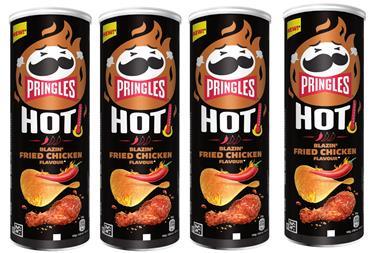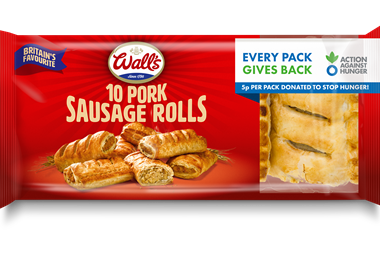W ith market analyst Mintel maintaining that sales of morning goods rose to nearly £4bn in 2008, there's more reason than ever for c-stores to make sure that the category is part of their bread and butter business.
"The UK bakery category is one of the most significant in the grocery industry," says Katie Rowson, customer category manager at Warburtons. "It's one of the top four categories that convenience shoppers consider as a reason for visiting convenience stores. Research shows that bread shoppers spend £1,300 a year in c-stores so it's a particularly important category for managers to focus on and get right."
As Mintel points out in its report on the market, bread and baked goods is one of the categories most likely to come out ahead in the current downturn. After all, whether a loaf is converted into warm toast or transformed into tempting sarnies, bread is a relatively inexpensive comfort food that even the most pennywise consumer is unlikely to strike off their shopping list.
"While in times of financial hardship consumers are cutting down on unnecessary purchases, they continue to buy core products such as bread," explains Rowson.
However, though the recession might not affect bread sales, the sector could face harder times in the future because of consumers' changing relationship with wheat. The trend for bread-phobia spread by the infamous Atkins Diet may have long faded, but despite a healthy rise of 4% year on year, Mintel says that the daily consumption of bread is steadily declining.
In a highly competitive market dominated by a few major players the challenge for manufacturers is to remind consumers that bread is a nutritious staple, while marketing fresh products that meet demands for health and convenience all at the right price.
For anyone who wants a snapshot of how the bread market is changing in the UK, it's a smart idea to take a look at the nation's breakfast tables, traditionally the place where much of our daily bread is eaten.
"The breakfast occasion is a key focus at Kingsmill as 31% of all bread is consumed at breakfast, making it the largest bread consumption occasion and a key opportunity to maximise sales," says Michael Harris, Kingsmill marketing controller.
Kingsmill has recently risen to the morning occasion with its £4m 'Wake up to Wholegrain' advertising campaign, which positions its Tasty Wholemeal and 50/50 products as healthy ways to start the day. The campaign has seen sales rise, but as time-poor consumers increasingly skip their slice of toast for a smoothie or cereal bar on the way to the office, brands may have to work harder in the future to keep bread on the breakfast agenda.
Though c-stores may lose out a little on bread for the morning market, there's evidence that they could boost sales by concentrating on lunch. Mintel believes that busy but thrifty consumers are foregoing store-bought sandwiches for food made at home, with more than half of consumers claiming to prefer making lunch from scratch.
To tap into the lucrative lunch market, this year Kingsmill launched a new Sliced Rolls range presented in a pack of 12 with resealable packaging designed to minimise waste.
"The rolls require minimal preparation time and deliver on health, providing customers with 40% of their daily wholegrain," says Harris.
Warburtons is also targeting sandwich-savvy consumers with their 2009 'Save Tons on Lunch' campaign, which features money-off coupons on special packs, plus the chance to win prizes at a dedicated website.
Price might be an important factor for consumers, but TNS says that health is now the fastest growing driver affecting the public's choice of bread products.
"Health as a reason for food choice has doubled over the last 10 years and consumers are more interested in the subject than ever before," says Rowson. "They're now looking for added health benefits from staples such as bread so they don't have to make vast changes to their existing diet and shopping habits."
Mintel says that these days 'health' now means much more than low-fat and calorie-controlled recipes. Functional seeded, wholegrain and multigrain variants have all proved popular, and now the door is open for manufacturers to take their lead from the margarine brands and offer more sophisticated health claims.
This year Hovis has built on its Best of Both range's existing fibre health claims by promoting the fact that two slices of the bread contain as much calcium as a pint of milk. Meanwhile, Kingsmill's 50/50 product is now available with added Omega 3 to capitalise on the attention that Omega fatty acids receive in the media.
With aggressive npd which sees new variants being released all the time, bread can be a deceptively complex market for analysts to track. However, the good news is that maximising bread sales in-store is relatively simple.
Category management experts recommend representing the biggest sellers on your shelves, while making sure that fresh stock throughout the day stops 'out-of-stock' signs from driving customers away.
"Some 80% of total bread sales consist of branded bread," says Harris. "As such, retailers should position branded products first in flow and ensure they have sufficient space."
"The UK bakery category is one of the most significant in the grocery industry," says Katie Rowson, customer category manager at Warburtons. "It's one of the top four categories that convenience shoppers consider as a reason for visiting convenience stores. Research shows that bread shoppers spend £1,300 a year in c-stores so it's a particularly important category for managers to focus on and get right."
As Mintel points out in its report on the market, bread and baked goods is one of the categories most likely to come out ahead in the current downturn. After all, whether a loaf is converted into warm toast or transformed into tempting sarnies, bread is a relatively inexpensive comfort food that even the most pennywise consumer is unlikely to strike off their shopping list.
"While in times of financial hardship consumers are cutting down on unnecessary purchases, they continue to buy core products such as bread," explains Rowson.
However, though the recession might not affect bread sales, the sector could face harder times in the future because of consumers' changing relationship with wheat. The trend for bread-phobia spread by the infamous Atkins Diet may have long faded, but despite a healthy rise of 4% year on year, Mintel says that the daily consumption of bread is steadily declining.
In a highly competitive market dominated by a few major players the challenge for manufacturers is to remind consumers that bread is a nutritious staple, while marketing fresh products that meet demands for health and convenience all at the right price.
For anyone who wants a snapshot of how the bread market is changing in the UK, it's a smart idea to take a look at the nation's breakfast tables, traditionally the place where much of our daily bread is eaten.
"The breakfast occasion is a key focus at Kingsmill as 31% of all bread is consumed at breakfast, making it the largest bread consumption occasion and a key opportunity to maximise sales," says Michael Harris, Kingsmill marketing controller.
Kingsmill has recently risen to the morning occasion with its £4m 'Wake up to Wholegrain' advertising campaign, which positions its Tasty Wholemeal and 50/50 products as healthy ways to start the day. The campaign has seen sales rise, but as time-poor consumers increasingly skip their slice of toast for a smoothie or cereal bar on the way to the office, brands may have to work harder in the future to keep bread on the breakfast agenda.
Though c-stores may lose out a little on bread for the morning market, there's evidence that they could boost sales by concentrating on lunch. Mintel believes that busy but thrifty consumers are foregoing store-bought sandwiches for food made at home, with more than half of consumers claiming to prefer making lunch from scratch.
To tap into the lucrative lunch market, this year Kingsmill launched a new Sliced Rolls range presented in a pack of 12 with resealable packaging designed to minimise waste.
"The rolls require minimal preparation time and deliver on health, providing customers with 40% of their daily wholegrain," says Harris.
Warburtons is also targeting sandwich-savvy consumers with their 2009 'Save Tons on Lunch' campaign, which features money-off coupons on special packs, plus the chance to win prizes at a dedicated website.
Price might be an important factor for consumers, but TNS says that health is now the fastest growing driver affecting the public's choice of bread products.
"Health as a reason for food choice has doubled over the last 10 years and consumers are more interested in the subject than ever before," says Rowson. "They're now looking for added health benefits from staples such as bread so they don't have to make vast changes to their existing diet and shopping habits."
Mintel says that these days 'health' now means much more than low-fat and calorie-controlled recipes. Functional seeded, wholegrain and multigrain variants have all proved popular, and now the door is open for manufacturers to take their lead from the margarine brands and offer more sophisticated health claims.
This year Hovis has built on its Best of Both range's existing fibre health claims by promoting the fact that two slices of the bread contain as much calcium as a pint of milk. Meanwhile, Kingsmill's 50/50 product is now available with added Omega 3 to capitalise on the attention that Omega fatty acids receive in the media.
With aggressive npd which sees new variants being released all the time, bread can be a deceptively complex market for analysts to track. However, the good news is that maximising bread sales in-store is relatively simple.
Category management experts recommend representing the biggest sellers on your shelves, while making sure that fresh stock throughout the day stops 'out-of-stock' signs from driving customers away.
"Some 80% of total bread sales consist of branded bread," says Harris. "As such, retailers should position branded products first in flow and ensure they have sufficient space."




























No comments yet